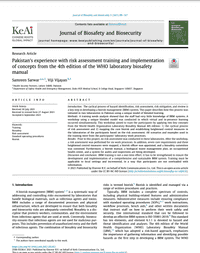Pakistan’s Experience with Risk Assessment Training and Implementation of Concepts from the 4th Edition of the WHO Laboratory Biosafety Manual
[Pakistan's Implementation of WHO Laboratory Biosafety Manual]
This resource examines the implementation of a biorisk management (BRM) system in two laboratories in Pakistan based on concepts from the WHO Laboratory Biosafety Manual, 4th edition. Users may find this example informative for implementing BRM training and developing a comprehensive, sustainable BRM system in settings with minimal prior implementation of formal BRM practices.
SUMMARY
This resource explains how a biorisk management (BRM) system was implemented in two laboratories in Pakistan based on concepts from the WHO Laboratory Biosafety Manual, 4th edition. Prior to training, a needs analysis demonstrated that laboratory staff had limited knowledge of BRM systems, and the project utilized the standard process of hazard identification, risk assessment, risk mitigation, and review to help the laboratories develop a BRM structure. To train participants in biosafety, researchers conducted a workshop using a blended learning model with a mix of online and in-person learning, including active learning strategies for adults. After the workshop, risk assessments were conducted, a biorisk officer was appointed, and a biosafety committee was convened. In addition, the laboratories began developing a biorisk manual, biological waste management plan, occupational health center, and a system for audits and inspections. Users may find this example informative for implementing BRM training and developing a comprehensive, sustainable BRM system in settings with minimal prior implementation of formal BRM practices.
This paper was co-authored by Samreen Sarwar of Health Security Partners and Viji Vijayan of the Department of Safety Health and Emergency Management at the Duke-NUS Medical School in Singapore. Funding for the project came from the UK government through the Fleming Fund Project. This project also applied two key concepts from the WHO Laboratory Biosafety Manual, 4th edition, including: 1) the cyclical process of risk assessment mentioned above, and 2) mapping the core biorisk and establishing heightened control measures in the laboratories of the participants based on the risk assessment. The paper is freely available as an English PDF.


..png)
